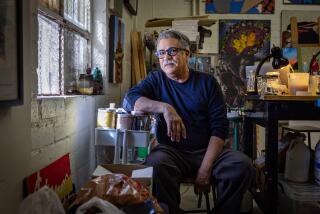Nancy Spero dies at 83; pioneering feminist artist
Nancy Spero, a pioneering feminist artist who examined the treatment of women and the horrors of war, has died. She was 83.
Spero died Oct. 18 in a Manhattan hospital of respiratory complications from an infection, said Mary Sabbatino, vice president of Galerie Lelong in New York.
Spero’s work combined drawing, painting, collage and printmaking. She was active in the women’s movement, and in the 1970s decided to focus on the roles of women.
“The basis of Spero’s artmaking is to isolate and juxtapose images of women,” Christopher Hume wrote in the Toronto Star in 1989. “Taken from a huge variety of sources, ranging from antiquity to now, these images frequently depict women as seen by men. This isn’t surprising of course but stripped of their context they’re more easily understood for what they are: sexist, degrading, brutalizing and often violent.”
Previewing Spero’s solo exhibit at the Museum of Contemporary Art in Los Angeles in 1988, The Times’ Elizabeth Venant described her works as “light and delicate, cut-out collage figures, largely appropriated and modified from art history sources, printed on scroll-like strips of paper.” In the same article, Art in America’s Donald Kuspit called Spero’s pictures “the most savage, unsentimental and incendiary feminist art I know.”
Spero was born in Cleveland in 1926. She earned a bachelor of fine arts degree at the School of the Art Institute in Chicago in 1949.
She met her husband, the painter Leon Golub, while a student in Chicago. In 1959, they moved to Paris, where they lived until moving to New York in 1964.
“I do know one thing about our relationship,” Spero told The Times in 1994, when she and Golub were subjects of a joint retrospective in Paris. “We’ve had some successes. Mine has come relatively late. And we’ve had a lot of ups and downs. But we have always pushed each other to the limit. Instead of getting back, we like to push each other to the edge.”
Spero examined Vietnam in the 1966-70 “War” series, which she revisited in a 2006 show. “Screaming figures were condensed into tight images. Helicopters crept around the walls at ceiling level, seeking their prey among art viewers,” wrote Thomas McEvilley in Art in America. “Elsewhere a ghostly helicopter of transparent blue dropped grenade-shaped bombs bearing more screaming figures.”
In “Torture of Women” from 1974-76, Spero “quotes case histories of women political prisoners in Chile and Iran, many reported by Amnesty International. Her collage figures of distorted faces and mythic, winged deities strain the backing paper with intentional water damage,” wrote Michael Scott in the Vancouver Sun in 1996. “Her rendering is ferocious, scrawling.”
Spero’s survivors include her sons, Paul, Phillip and Stephen. Golub died in 2004.
A retrospective of her work is scheduled next year at the Centre Pompidou in Paris.
More to Read
The biggest entertainment stories
Get our big stories about Hollywood, film, television, music, arts, culture and more right in your inbox as soon as they publish.
You may occasionally receive promotional content from the Los Angeles Times.






